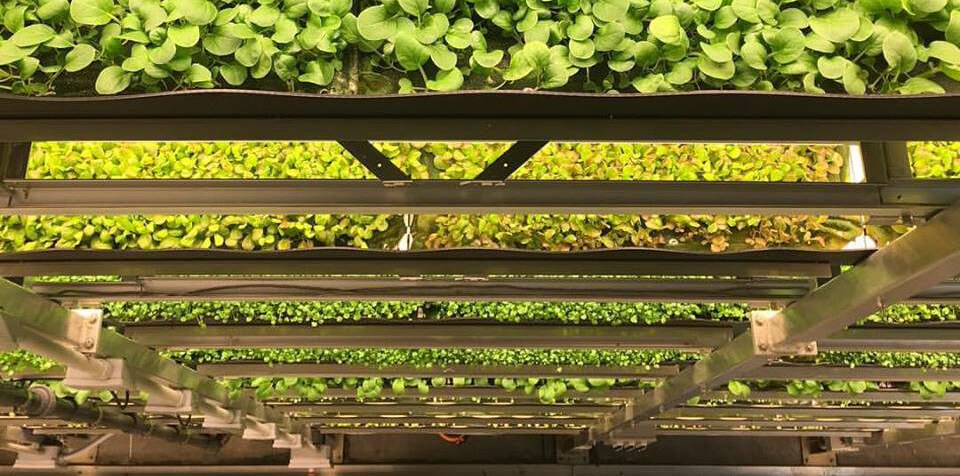
By Nikcole Thompson.
For the first time in U.S. history, urban agriculture was recognized in the legislation of the 2018 Farm Bill. This is fantastic news, as climate change and generations of over-farming have left our soils ravaged. Soil degradation, coupled with population density and water scarcity, is the perfect storm for a global food crisis. According to the United Nations, there will be more than 9 billion mouths to feed by 2050. Traditional agriculture, while flawed, does one thing well; it produces large quantities of food.
In the last twenty years, innovations like hydroponics, aquaponics, and aeroponics have emerged. Using less space, less water, and little-to-no natural sunlight, these methods of producing food have redefined agriculture. Moreover, the recent farm bill legislation will provide funding to ensure that the players in these systems have a fighting chance at proving their worth. These systems can produce an impressive amount of produce in small spaces, urban spaces, and even in outer space!
Hydroponics
Hydroponics is a system which uses growing mediums in place of large plots of soil. The root system of the plant emerges in an oxygen-rich nutrient solution. While it can be technology- and capital-intensive, it provides a high yield when used in addition to or in conjunction with a greenhouse.

Since hydroponic systems account for both the root and the aerial environment, production must take place inside a regulated or controlled structure. Additionally, hydroponics is incredibly water-intensive, so Arizona may not offer the ideal climate for this system. Brendan Woltman, the owner of EcoGro, a one-stop supply shop for sustainable growing systems in Tucson, says that because of the high evaporation rate of hydroponics systems, EcoGro instead recommends aquaponics systems for Arizona backyards.
Aquaponics
Aquaponics takes hydroponics one step further. Aquaponics is a closed-loop system that uses fish, prawns, snails, or crayfish as a symbiotic addition to the hydroponic cycle. The aquatic animals supply nitrogen for the plants and, in return, the plants feed the aquatic animals. Jon Vitton, owner of Harvest 480 in Chandler, Arizona, uses aquaponics to grow some of his herbs and romaine lettuce. While he still supplements with necessary minerals, he feels the aquaponics system is very stable once it gets started. “I see the water in this system very much like pond water.

In Arizona, I have found goldfish to be very good for my system,” says Vitton. “I started with tilapia but found it much easier to source the goldfish and easier to keep up with nutrient production over the winter months because tilapia’s metabolism slows way down in the winter. I use a combination system of vertical towers and ebb and flow beds. I find benefits in both types,” Vitton says. Woltman is a proponent of aquaponic systems because they use 90 percent less water than hydroponics, they are lower input – not requiring synthetic nutrients – and beyond growing your greens, you are also growing your protein.
Aeroponics
Aeroponics is a system that grows plants without the use of a growing medium and with very little water – instead, it essentially relies on oxygen, mist and LED light to produce plants. This system has been utilized by NASA scientists in space since the mid-’90s, and here on Earth, AeroFarms is making serious gains in the aeroponics industry.

AeroFarms, a 69,000-square-foot operation based in Newark, New Jersey, is currently the world’s largest aeroponic farm and produces 2 million pounds of greens a year. Their greens are free of pesticides, and their patented technology uses 95 percent less water and 50 percent less fertilizer than traditional vegetable farming. They even employ the use of sensors on their growing trays, which collect data to track growth. The data is analyzed by scientists at MIT and Harvard, allowing improvements to be made with ease.
A New Era in Food
An impending food crisis is a real concern, but these technological feats in agriculture give us tangible hope. It’s true that we have reached a critical point, but we can take solace in the fact that humans are doing remarkable work in the agricultural industry – locally and beyond. In Tucson, EcoGro is heavily involved with the community. They have partnered with the Fred G. Acosta Job Corps Center, the VA, Biosphere 2, local school districts and reservations to educate and empower the community to grow their own food using aquaponics.
On the first Tuesday of every month, EcoGro organizes a meetup at the University of Arizona called Tucson AquaPonics Project. For more information, visit meetup.com/Tucson-AquaPonics-Project. To learn more about Harvest 480, visit harvest480.com.
Nikcole Thompson is a writer, mixed-media artist and editorial intern for Green Living Magazine based in Phoenix, Arizona. When she is not writing, she can be found among plants at the local nursery she works for or working on her Bachelor of Science at Arizona State University. Follow her on Instagram @nlt.artworks.








I want to be involved.
Stephen Andrews